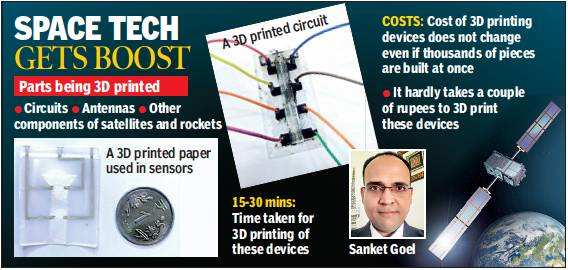Academic Deploys 3D Printing Tech For Space Projects

HYDERABAD: A professor from the city is 3D printing circuits, sensors, antennas, and other components of satellites and rockets that can work in extreme conditions.
Sanket Goel, associate professor, electrical and electronics engineering (EEE), BITS Pilani, Hyderabad campus, who is working on ‘Digital 3Dprinted Electronic Technology for Space Electronic Packaging Applications’, a project funded by Indian Space Research Organisation (ISRO), has used fused deposition modelling 3D printer to build circuits, radio-frequency identification antennas, and hydrazine, a chemical released during the launch of a rocket, sensor.

“These are highly reliable, low weight, last longer, and can work in extreme weather conditions,” told Goel TOI. Unlike the copper-based printed circuit board, he said the 3D printed ones overcome corrosion and bending.
Goel said this is probably the only project in the country, where they are 3D printing devices for space applications. “For sure, we are among the first ones to 3D print electronic devices for space application. Unless new projects have started in the last couple of years, we are the only ones doing this,” he said.
He said as it was a project of ISRO, and it is hard to tell when and where the circuits would be used. “The 3D printed circuits, antennas might be used as space components in two years or 10 years. As it is confidential, not much information is revealed to us,” he said.
Explaining the hydrazine sensor, Goel said: “It is important to monitor the level of hydrazine, a highly toxic chemical component, both during the launch of a rocket and inside the aircraft. The senor is used to monitor the level and alert when it is high so that it can be removed.”
He said that while the production cost of circuits, antennas, or sensors might go down when manufactured in bulk in the traditional way, the cost of 3D printing these devices would not change even if thousands of pieces were built at once. “Whether you make one or 1,000, the cost remains the same,” Goel said, adding that it would hardly take a couple of rupees to 3D print these devices and the duration would be about 15 to 30 minutes.
Goel, who is the principal investigator on this project, said he and his students were working on this project since 2018 and it was on the verge of completion. He said these devices could also be printed using a metal 3D printer, but it would cost crores of rupees to procure such printers.
He said that he is also working with the department of science and technology and DRDO on 3D printing energy harvesters and supercapacitors.



No comments:
Post a Comment